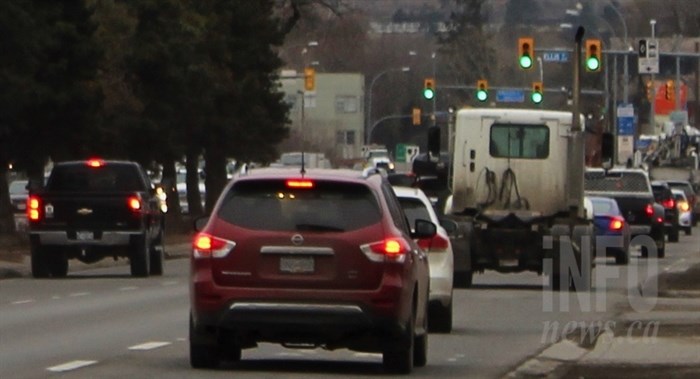
Traffic lights are coordinated along two stretches of Highway 97 through Kelowna, Abbott Street to Gordon Drive and Burtch Road to Highway 33.
(ROB MUNRO / iNFOnews.ca)
January 15, 2019 - 6:30 AM
KELOWNA - Traffic light coordination isn’t supposed to mean hitting nothing but red lights. That’s just the perception rush hour drivers may have on their daily commute, especially on Highway 97 through Kelowna.
“Right now, we’ve got the best timing in place that we can for the amount of volume and the direction of traffic,” Kenedee Ludwar, director of traffic and highway safety for the Ministry of Transportation, told iNFOnews.ca. “That said, we do continually review our traffic plan to meet the needs on the road."
The province has control of traffic lights along the Highway 97 corridor and Ludwar noted the stretch through the Central Okanagan is one of the busiest in the province that has traffic lights. Highways in the Lower Mainland, by contrast, tend to be divided roads with overpasses.
The Ministry does coordinate traffic lights along two stretches of the highway in Kelowna – from Abbott Street to Gordon Drive and from Burtch Street to Highway 33.
In those sections, each light has a minimum time to stay green but that time changes so the green lights are longer during rush hours. Each successive light is set to turn green based on the time it takes for cars that are driving the speed limit.
But there still needs to be accommodation for cross traffic. Left turn and pedestrian signals also complicate the picture.
There is no traffic light coordination through West Kelowna.
“We found, when we looked at traffic flow patterns, it was more effective to keep it out of coordination,” Ludwar explained. “We look at how vehicles are travelling, whether they’re travelling in platoons or in groups and whether or not it’s more efficient to try to have them continue to move in those groups. We found, with our modelling, that we have better travel time through (West Kelowna) if we don’t coordinate.”
That same thinking applies to traffic lights on Kelowna city streets.
“Signals can be set up to operate stand-alone at each intersection or they can be set up to be coordinated,” said Gordon Foy, transportation and engineering manager with the City of Kelowna. “The vast majority of our signals are operating in a stand-alone fashion. They are trying their best to service the traffic demand at that intersection. They can sense where traffic is and they can extend the green or shorten the reds. Each time they go through the cycle they can do that individually at that intersection.
There are coordinated signals along parts of Gordon Road, Springfield Road, Glenmore Road and some others but in many locations stand-alone lights work better.
City council agreed in December to spend $65,000 this year to update its traffic data along Gordon and Springfield to see if lights can be better coordinated. If that proves to be the case, the city may look at reviewing other streets. Foy said it will be later in 2019 before the results of the review are known.
Most of the city’s traffic lights and all of the province’s traffic lights are triggered by coils looped in the pavement. They detect metal in vehicles. The coils can keep the green lights longer when there is a steady stream of traffic. When there’s a gap, that can be the signal to switch the green light to the cross street.
All new traffic lights owned by the City of Kelowna, and some of the older ones, are now using cameras instead of coils.
While the cameras are, initially, more expensive, having cuts in the pavement leads to damage to the road when water gets in and freezes, Foy said.
The cameras are low resolution. They can tell the difference between a car and a bicycle, for example, but cannot identify the type of car.
City traffic signals are also set to detect buses in an effort to give them a longer green if they’re behind schedule. That doesn’t happen on the highway but, Ludwar explained, the High Occupancy Vehicle lane is designated as the curb lane, in part, because of the bus stops along the highway.
Signals can also be adjusted for emergency vehicles when sirens are activated and lights are flashing.
The province is upgrading some of its traffic light technology. Foy is hoping that will allow the city to work on some cross street coordination. One key street is Richter Street where traffic lights are very close on Leon Avenue and Lawrence Avenue so coordination could ease some congestion there.
To contact a reporter for this story, email Rob Munro or call 250-808-0143 or email the editor. You can also submit photos, videos or news tips to the newsroom and be entered to win a monthly prize draw.
We welcome your comments and opinions on our stories but play nice. We won't censor or delete comments unless they contain off-topic statements or links, unnecessary vulgarity, false facts, spam or obviously fake profiles. If you have any concerns about what you see in comments, email the editor in the link above.
News from © iNFOnews, 2019